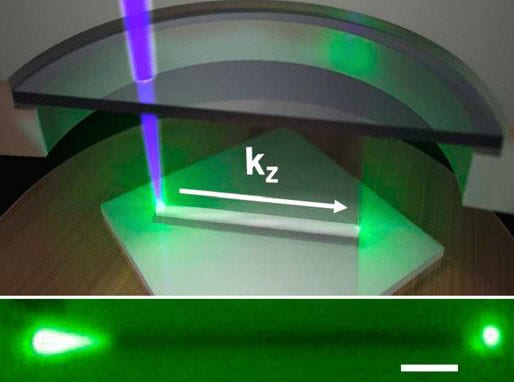
Researchers at the University of Pennsylvania in the US claim that polaritons – quasiparticles that are part matter and part light – couple more strongly when confined in nanoscale semiconductors. The new result could benefit photonic circuits that exploit light rather than electricity.
A polariton is a particle-like entity (or quasiparticle) that can be used to describe how light interacts with semiconductors and other materials. It has two different components: an electron-hole pair (or “exciton”) and a photon, which is emitted when the electron and hole recombine. When a photon is emitted, it is immediately reabsorbed to reform an exciton, so the cycle is repeated. This continuous exchange, or coupling, of energy between photons and excitons can be described in terms of polariton states.
Polaritons are expected to play an important role in future photonics devices that would use light instead of electricity to process information. Such devices would be much faster and use less energy than their electronic counterparts. The strong coupling of polaritons will be crucial for the success of this new photonics, but the coupling strength of polaritons in bulk semiconductors was always thought to be limited by the properties of the semiconductor material itself.
The right finishing techniques
Ritesh Agarwal and colleagues are now saying that this limit can be overcome if the right fabrication and finishing techniques are used to make the semiconductor structures in question. This is because the light-matter coupling strength increases dramatically as semiconductors become smaller than 500 nm or so, explains Agarwal.
“When you’re working at bigger sizes, the surface is not as important,” he said. “The surface to volume ratio – the number of atoms on the surface divided by the number of atoms in the whole material – is a very small number. But when you make a very small structure, say 100 nm, this number is dramatically increased. Then what is happening on the surface critically determines the device’s properties.”
Although researchers had previously attempted to make polariton cavities on such a small scale, the “top-down” chemical etching methods employed to fabricate the devices damaged the semiconductor surfaces, so creating defects. These defects trapped the excitons, making them unavailable for transporting current.
Self-assembling nanowires
Agarwal’s team overcame this problem by self-assembling nanowires made from cadmium sulphide instead of etching nanoscale structures. Surface quality was still an issue, even with this fabrication technique, so they developed a way to “passivate” the surface of the nanowires by growing a silicon oxide around them. This greatly improved the optical properties of the wires because the oxide shell fills the electrical gaps in the nanowire surface and prevents the excitons from getting trapped on the surface, says Agarwal.
The scientists also developed techniques (based on detecting the energy of standing waves formed in the nanowire cavities) for measuring the light-matter coupling strength and showed that it was indeed enhanced as the semiconductor structures became smaller. Stronger light-matter coupling means faster photonic switches and much more efficient polariton lasers, light-emitting diodes and amplifiers – to name a few possible applications.
However, not all scientists are convinced of the team’s results. Benoit Deveaud-Plédran of École Polytechnique Fédérale de Lausanne described the team’s claims as “overstated” and said that they don’t appear to be backed up by data presented in a paper outlining the experiment (PNAS 108 10050 ).
Others are more enthusiastic. “This paper looks like an interesting addition to the armoury of light-matter strong coupling effects in semiconductors,” commented Jeremy Baumberg of the University of Cambridge’s Cavendish Laboratory in the UK. “The results show a new way to reduce the volume of the microcavity, by using high refractive index nanowires, which tightly confine the light inside. The rate at which energy is flipped back and forth between light and excitons depends on inverse square root of the volume within which the light is trapped. Here the wall of the semiconductor is used to confine the light, and it is tighter than normal, giving rise to faster rates and thus a higher splitting between the polariton ‘modes’.”
Improvements needed
It is an interesting new route to making strong coupled systems at room temperature, he told physicsworld.com, but the design might not be more than just “fortuitous”, Baumberg cautions. The light leaks out from the structure in many directions, and is not confined well enough to keep the resonances narrow. “Improvements will rely on much better control of the length, width, orientation and out-coupling of light from nanowires,” he added.
Other teams around the world are also looking at new ways of achieving room temperature strong polariton coupling. Baumberg’s group, for its part, has recently published a paper in Applied Physics Letters describing a set-up that comprises air suspended mirrors and simpler semiconductors based on the well known gallium arsenide. This system has light out-coupled in only vertical directions and it can be electrically controlled.



